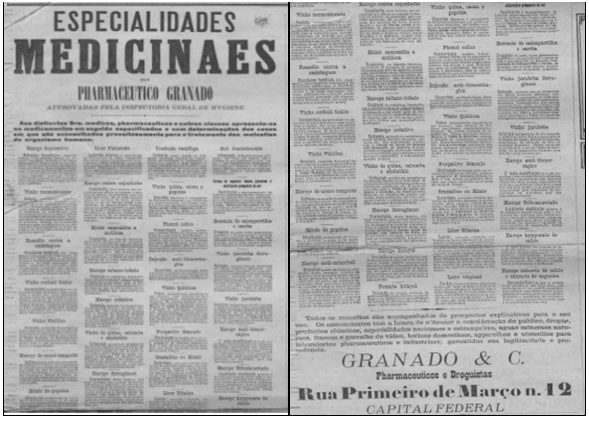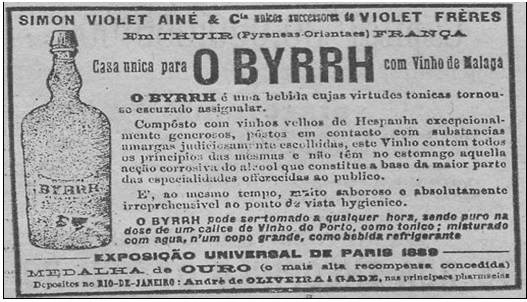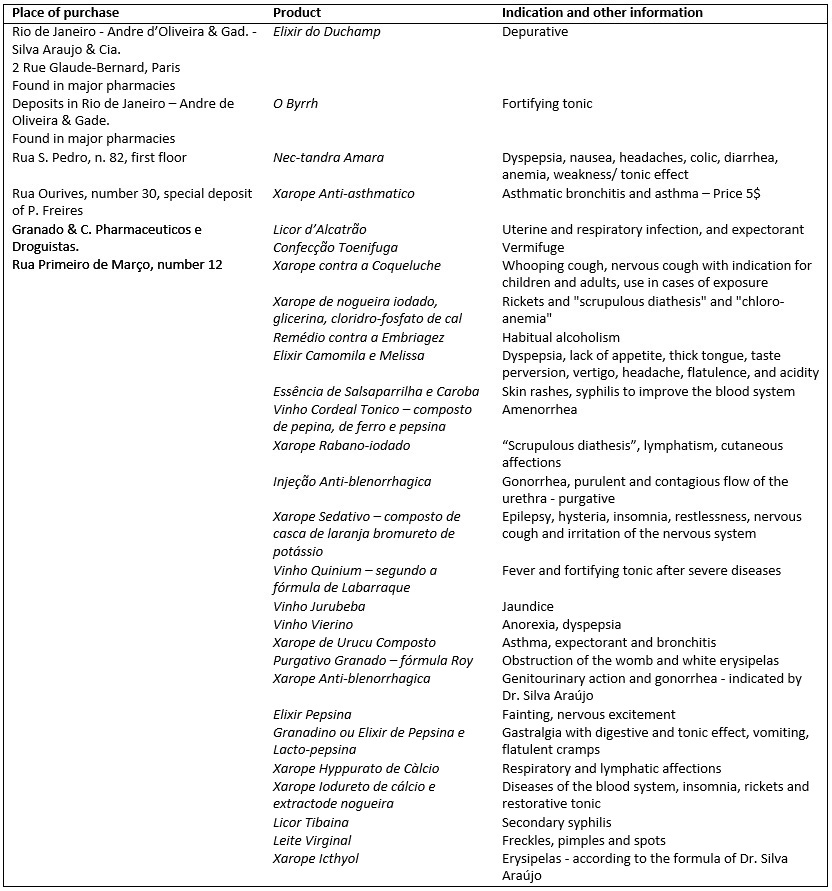
Figure 1: Publicity by the pharmacist Granado. Rio de Janeiro, 1891
ORIGINAL RESEARCH
Body and care in advertising in the Jornal do Brazil newspaper (1891)
Pedro Ruiz Barbosa NassarI; Keythluci Faria Trigueiro da SilvaII; Claudia Cruz da SilvaIII; Simone Aguiar do NascimentoIV; Mercedes NetoV; Fernando Rocha PortoVI
I
PhD student in Biosciences of Federal University of the State of Rio de
Janeiro. Professor of Veiga de Almeida University. Rio de Janeiro, Brazil.
E-mail: pedrornassar@gmail.com
II
Nursing student of Federal University of the State of Rio de Janeiro.
Scholarship for Scientific Initiation. Rio de Janeiro, Brazil. E-mail: keythlucifaria@gmail.com
III
Master. Nurse at Gaffreé Guinle University Hospital. Member at Laboratory
of Nursing Care and Images. Rio de Janeiro, Brazil. E-mail: ccs.claudiacruz@gmail.com
IV
PhD student in Biosciences of Federal University of the State of Rio de
Janeiro. Supervisor of the Regional Council of Nursing. Rio de Janeiro,
Brazil. E-mail: siraguiar@hotmail.com
V
PhD. Adjunct Professor, Public Health Nursing Department. Rio de Janeiro
State University, Brazil. E-mail: mercedesneto@yahoo.com.br
VI
Post-Doctoral. Associate Professor, Department of Maternal and Child
Nursing. Federal University of the State of Rio de Janeiro, Brazil. E-mail: ramosporto@openlink.com.br
DOI: http://dx.doi.org/10.12957/reuerj.2016.17365
ABSTRACT
Objective: to study body care advertisements by way of the Jornal do Brazil of 1891. Method: the micro-history perspective was used, permitting analysis of five advertisements published in the first issue in Rio de Janeiro City. Results: the advertisements were intended to foster consumption of body care products for internal or external use and to indicate mixed use. Results: the advertisements announced place of sale, and only one stated the price of the product. Conclusion: the study presented several ideas, among them that the advertisements are historical records from which to learn how the population cared for the body at the time, more precisely in the city of Rio de Janeiro - Federal District.
Keywords: Body care; environment; press; pharmacy.
INTRODUCTION
The press in Brazil was officially created as one of the first measures introduced by the Court after the arrival of the Royal Family in the country with the creation of the Regional Press, in 1808.
The first newspaper, called Gazeta do Rio de Janeiro, was edited by the Regional Press with records of the European political landscape and its developments as well as the publication of adverts1.
The printed press allows the production of a cultural heritage, which is fundamental to understand the phenomena and socio-cultural processes produced in each epoch. In this sense, the press influences and helps to explain the culture, as well as registers the tensions, interests, strategies and complexity of any given situation in time.
This register, when understood as production of meaning, is expressed through an elaborated discourse, in general by a certain social class or by an alliance that makes some interest possible and strategy that is at stake, which leads to the controlled transmission of verbal and non-verbal messages1.
The newspaper is a vehicle of plural materiality, marked by different forms of presenting, analyzing and working the word by narrating what it intends to state. In the newspaper, you can find reports, news and adverts. The latter is considered a historical record that is rich in content, because it represents demand related to a certain dimension, sometimes particular to human needs1.
Advertisements can be categorized as propaganda or merchandising. Propaganda refers to the promotion of a political, religious or ideological cause related to a certain fact with the aim of disseminating ideas. Merchandising, on the other hand, is intended to give meaning to commercial promotion, which aims to stimulate the consumption of goods or services2. In this last perspective, health-related adverts were published in the first issue of the Jornal do Brazil on April 9, 1891, in the city of Rio de Janeiro.
These adverts can be taken as vestiges left by the past and when analyzed in the present, collaborate to the understanding of the daily life in old times3.
Thus, the aim of this study was to investigate advertisements in the Jornal do Brazil (1891) focused on the care of the body.
The justification for this study is the interest in the history of care from the perspective of a microanalysis in the construction of the science of care.
THEORETICAL REFERENCE
As a theoretical reference, this study is based on some elements of the theory of communication, namely transmitter, message, receiver, code, channel and referent. This relates to the understanding that in order to have an efficient communicative act these factors must contribute to the communications4.
When applying such theoretical elements to a study, one can understand that: the sender is the one who produces the message - the producers of the adverts and the receivers are those who receive the transmitted message - the readers of the Jornal do Brazil. Moreover, the message is the transmitted information - the advertisement; the code is the elements that produce the message - linguistic system and visual resources; the channel is where the message was transmitted - the Jornal do Brazil and the referent is the situation to which the message refers - caring for the body.
These elements should not be understood in a simplistic way, since the way the message is received and assumed depends on the values, ideologies, and view of the world, among other aspects, which decide the strategy of persuasion so that communication produces the expected effect - consumption.
METHODS
The documents used for the analysis were five advertisements published in the first issue of the Jornal do Brazil published in 1891, that was mainly circulated in the streets of the city of Rio de Janeiro, the then capital of Brazil.
The five advertisements published in the first issue of the Jornal do Brazil to advertise body care products were presented as different sizes in a row as if it were a single section. The letters were small, a font size of approximately nine or ten, making it necessary the use of magnifying glass to read the words. Two of these adverts were photographs of previous advertisements that had larger text sizes and images of the products to be consumed.
In order to analyze the merchandising using the microanalysis perspective, a table was constructed with three columns: place of purchase, name of the product, and its indication and further information. This can be understood by the application of the game of scale, as it may be able to expand or reduce the scope of the object of study and the set circumscribed to it5.
RESULTS AND DISCUSSION
Jornal do Brazil
Published a few years after the proclamation of the republic of Brazil, the Jornal do Brazil was first published on April 9, 1891. The date corresponds to the political ideology that it defended, because it is the date of the sixtieth anniversary of Te Deum, celebrated when Dom Pedro II ascended the throne6. The Te Deum is a traditional liturgical hymn; several composers, including Mozart, Haydn, Berlioz, Bruckner, Dvorák, and even Emperor Pedro I of Brazil wrote different musical scores for Te Deum3.
The first page of this newspaper stated its name and its objectives, which were to defend of the legality of the constitution and the interests of the country. Among the different items that appeared in this first issue were advertisements, categorized as merchandising.
Merchandising for the care of the body and the environment
The first advertisement occupied about a quarter of the page of the newspaper that measured 55 x 35 cm. This advert, measuring 13 x 35 cm, was entitled "Especialidades medicinaes pelo Pharmaceutico Granado – e aprovadas pela Inspectoria Geral de Hygiene" ("Medicinal specialties by the pharmacist Granado - and approved by the General Inspectorate of Hygiene").
The advert (Figure 1) features thirty-five descriptions of different types of body care drugs. This publicity was presented by the pharmacist named Granado.

Figure 1:
Publicity by the pharmacist Granado. Rio de Janeiro, 1891
The following texts are presented at the beginning and at the end of the advert:
[Beginning] To the distinguished physicians, pharmacists and other classes we present the remedies specified below with determinations of the cases in which they are not advised to treat the diseases of the human organism.
[End] All medicines are accompanied by explanatory leaflets on their use. The advertisers have the honor to offer for public consideration, drugs, Chinese products, national and foreign specialties, natural mineral waters, vials and glass bottles, domestic apothecaries, apparatuses and utensils for pharmaceutical and industrial laboratories, guaranteeing their legitimacy and provenance 7:3.
The text is written using the spelling of words from the year 1891, informing readers - laypeople and doctors, pharmacists and people of other employment categories - that the remedies were accompanied by informative instructions, citing further that the products were of national and foreign specialty with guarantee of provenance.
The above-mentioned convincing arguments served to make the advertiser credible for the products he advertised for consumption in the care of the body. Put another way, the users of such products could be free of the ills of the body, without the annoyances that impaired a good life.
The second advert refers to the use of Duchamp Elixir. This publicity was presented with the visual appeal in the format of a bordered rectangle 8. The layout used for the Duchmap Elixir makes the product stand out, which was intended to draw the reader's attention due to the diversity of information that was printed on that page of the newspaper.
The third advert (Figure 2) is for a drug called O Byrrh. This advert also used the visual resource strategy of a box, but the content differed because it presented an image of the bottle of the product7.

Figure 2:
Advert of the medication O Byrrh. Rio de Janeiro, 1891.
By directly presenting the product packaging, the advert stands out on the page, calling the reader to look at the bottle of O Byrrh. Although the image is not clear, it gives an idea of the appearance of the product.
The fourth advert is for Nec-tandra Amara. Its presentation only uses text without attracting the attention of the reader, with its highlight being the expression at the beginning of the text "The patient", in large bold-type letters, which are not used in the rest of the publicity.
The fifth advert refers to xarope anti-asthmatico (anti-asthma syrup), which also has an unattractive visual appeal, but the words "Asthema" and "Bronchite asthmatiga" stand out because the letters are larger and in bold type compared to the rest of the text.
The visual resources, directly or indirectly, want to draw the reader's attention to the content of the advert through the "force" of the advertising language. Thus, it is believed that the adverts address the applicability of the technique denominated AIDA, that is, "Attention, Interest, Desire, Action" 9. This technique aims to draw the attention of the reader by the interest of the subject, arousing the desire, in the case of necessity, and taking an attitude, understood as an action. In this perspective, advertising leads, consciously or unconsciously, to arouse the reader's desire to consume, which may result in the purchase of the product.
After reading the names of the products and the visual appeal strategy used to result in their consumption, the following questions arise: Where were these products on sale and what were their uses? Table 1 was organized to answer these questions.

Figure 3:
Places of purchase and products marketed (1891)
The indications for the consumption of the products were classified as internal use, external use and mixed use (both for the body and for the environment). Thus, 36 medications in the adverts were indicated for internal use, two for external use (Virginal Milk and Icthyol Ointment) and one was indicated for mixed use (Phenol Sodium).
The indication for the use of the medications presented in the adverts suggests the possibility that the population, at that time, was more affected by diseases of the respiratory system, the nervous system and infectious diseases, and that the most common effect of the drugs was as fortifying tonics. On the other hand, one can also consider a commercial strategy leading to consumption by induction.
It should be noted that by the end of the 19th century, evidence of the existence of microorganisms gave several explanations for the validity of some bacteria that affected human beings, leading some authors to call it the "bacteriological era". This conceptualization produced sanitary discourses and practices in which individuals became as important as or more important than the environment as a source of contamination 10. In this perspective, the interaction of the individual with the environment evolved in discourses and practices that, in the following century, would be enhanced by various movements to improve public health, especially in the city of Rio de Janeiro.
Another fact that deserves attention, even though it was only mentioned in one advert, is the value of the product. The advert of the anti-asthmatic syrup informed the reader of the cost; 5$ (five contos de rèis – the Brazilian currency at that time) 8 per bottle. It should be noted that the cost of subscription of the Jornal do Brazil was 6$000 (contos de réis) per semester, and 12$000 (contos de reis) annually in the capital, 8$000 (contos de reis) per semester and 15$000 (contos de reis) annually in the States and a single copy was 40$ (contos de reis). Thus, the value of a copy of the Jornal do Brazil was more expensive than a bottle of anti-asthmatic syrup, which serves as a parameter to consider the low cost of medications.
The establishments announced in the adverts were the main pharmacies of Rio de Janeiro. Of the five adverts, three presented their addresses, where it was possible to find the product, namely: the products sold by Granado & C. Pharmaceuticos and Droguistas were available at Rua Primeiro de Março, nº 12; anti-asthmatic syrup was sold at Rua Ourives, 30 and the medication Nec-tandra Amara was on sale at Rua S. Pedro, nº 82, first floor.
It should be noted that all the streets mentioned by the advertisers were in the center of Rio de Janeiro, each with its respective history that reveals its importance to the city11.
The commercial and financial activities of the capital city were concentrated in the center of Rio de Janeiro surrounded by residential zones. Hence, the place was conducive to the marketing of medications.
CONCLUSIONS
The advertisements analyzed revealed, through verisimilitude, how the population of the late nineteenth century took care of their bodies, as well as, perhaps, the most commercialized or the most common remedies with the sales outlets centralized in the commercial and financial center of the capital city. One advert reported the price of the product in the Jornal do Brazil.
This led to the reflection that the care with the body was a concern that professionals and laypeople had in regard to bodily hygiene habits.
We consider the adverts to be documents to be explored in order to investigate the care people took – they are historical records to investigate the past, and may be another way to return to the past from the present. A path that can reveal practices, knowledge and attitudes in the sense of filling some of the gaps of care of the body.
REFERENCES
1. Porto F. A imprensa escrita como fonte de pesquisa para a enfermagem. Rev Enferm Brasil. 2007; 6 (3): 72-8.
2. Veraldo TX, Porto F. Aparelhagem da imagem pública da enfermeira. Rev pesq cuid fundam online. [Internet] 2012 [cited in 2016 Mar 05]; 4(4):2776-88. Available from: http://www.seer.unirio.br/index.php/cuidadofundamental/article/view/1899/pdf_616
3. Ferreira M.M. Jornal do Brazil. In: Dicionário histórico-geográfico. Beloch I, Abreu AA, coordenadores. Rio de Janeiro: Forense Universitária, FGV/CPDOC; 1984.
4. Fiorin JL, Savioli FP. Lições de texto: leitura e redação. São Paulo: Ática Didáticos; 2006.
5. Burke P. A escrita da História. São Paulo: Unesp; 2011.
6. Freitas TM, Porto F. Cuidados com o cordão umbilical do recém- -nascido, no século XIX. Rev enferm UERJ [Internet] 2011 [cited in 2016 July 08]; 19(4):524-9. Available from: http://www.facenf.uerj.br/v19n4/v19n4a03.pdf
7. Conferência Nacional dos Bispos do Brasil - CNBB [Internet]. 'A vós, ó Deus': o significado do Te Deum, 01 de Janeiro de 2012. [cited in 2016 Jun 14]. Available from: http://cnbb.org.br/site/imprensa/internacional/8412-qa-vos-o-deusq-o-significado-do-te-deum
8. Jornal do Brazil. Especialidades medicinaes do pharmaceutico Granado – approvadas pela Inspectoria Geral de Hygiene. Jornal do Brazil. 1891; 1(1): 3.
9. Coaracy V. Memórias da Cidade do Rio de Janeiro. Itatiaia (SP): Universidade de São Paulo; 1998.
10.Porto F. Cuidado seguro em pediatria: produção do sentido na imprensa escrita. Rev. pesq. cuid. fundam. online. [Internet] 2011 [cited in 2016 Mar 05]; 3(3):2191-6. Available from: http://www.seer.unirio.br/index.php/cuidadofundamental/article/view/1571/pdf_425
11. Larocca LM, Marques VRB. A construção do novo Paraná: uma análise dos discursos higienistas (1853-1930). Cogitare enferm. [Internet] 2010 [cited in 2016 Jun 19]; 15(1):153-7. Available from: http://ojs.c3sl.ufpr.br/ojs2/index.php/cogitare/article/view/17187/11322
12.Banco Central do Brasil. Padrões monetários. [internet] [citado em 29 mar 2016]. Available from: http://www.bcb.gov.br
13.Geovanini T. História da enfermagem: versões e interpretações. Rio de Janeiro: Revinter; 1995.
14.Oguisso T. As origens da prática do cuidar. In: Oguisso T, Cinciarullo TI, organizadoras. Trajetória histórica e legal da enfermagem. São Paulo: Manole; 2008. p.3-29.
15.Silva RS, Matos LSL, Araújo EC, Peixoto GPN, Costa LEL, Pereira A. Práticas populares em saúde: autocuidado com feridas de usuárias de plantas medicinais. Rev enferm UERJ [Internet] 2014 [cited in 2016 Mar 05]; 22(3):389-95. Available from: http://www.e-publicacoes.uerj.br/index.php/enfermagemuerj/article/view/5077/10946